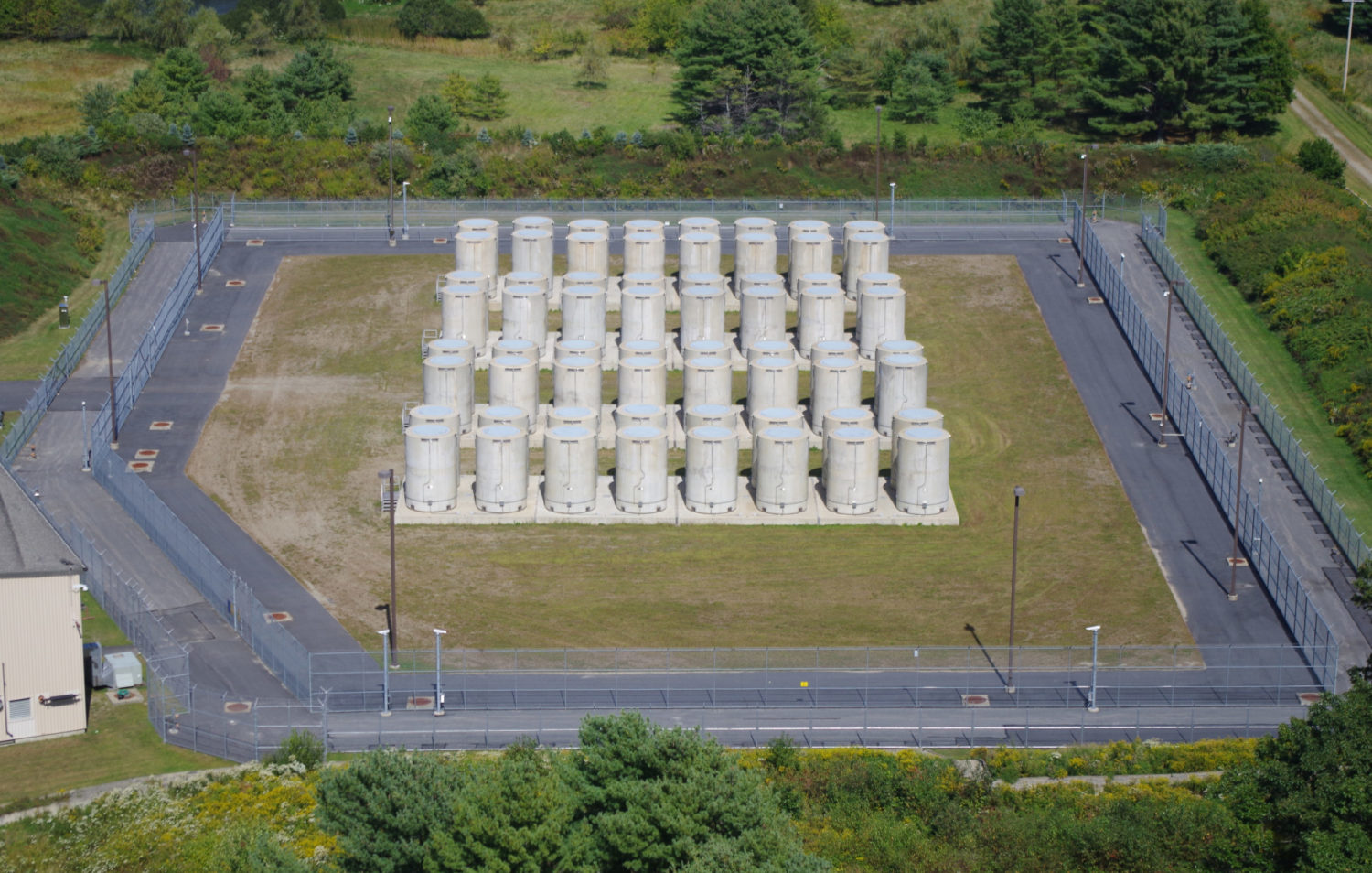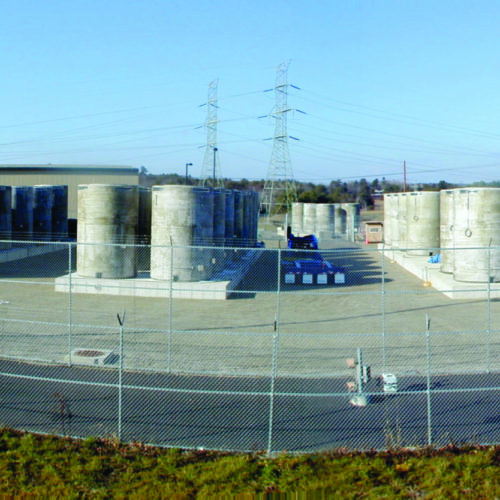Engaging communities in a nuclear waste storage solution
This article appears in the 2022-23 edition of Perspectives.

Credit: Maine Yankee
On a quiet patch of land in the rural town of Wiscasset, Maine, armed guards monitor dozens of concrete structures containing radioactive waste. The land is the former site of Maine Yankee Nuclear Power Plant, once Maine’s largest generator of electricity, which shut down in 1997. Now, all that remains are 60 dry casks filled with spent fuel and 4 more containing irradiated steel, all in need of a permanent home.
The waste should have been gone by now, but Congress’s failure to designate a long-term repository has left it stranded at 74 sites across the country, including Maine Yankee, costing taxpayers billions.
In recent months, the Biden administration has resolved to find a near-term solution to the waste storage challenge, by asking communities to consent to participate in siting a facility. The hope is that through sustained public education and engagement, the initiative will succeed where previous efforts have failed: in garnering local acceptance and support for an interim site to store highly radioactive waste safely — at least until Congress agrees on a permanent location.
“We recognize that there has been a trust deficit between the DOE and the communities we are looking to serve,” said Sam Brinton, deputy assistant secretary for spent fuel and waste disposition at the Department of Energy Office (DOE) of Nuclear Energy, during a webinar in October. “This is going to build bridges and help to regain some of the trust that has been lost,” they said.
Restarting a public dialogue
Asking a community to consent to hosting a facility represents a stark departure from the top-down siting model that resulted in the federal government’s designation in 2002 of Yucca Mountain, in Nevada, as a long-term repository. That decision led to a backlash among local residents and others, and eventually to rejection of the site seven years later.
The new initiative seeks to build on a consent-based process launched by the Obama administration in 2016. At the time, then-DOE Secretary Ernest Moniz acknowledged that Yucca Mountain’s failure made clear that a plan to build a repository in a community or state that did not agree to host it was unworkable. Agency officials met with local governments, tribes, and residents across the country to get their input on what a fair siting process should look like. Officials repeatedly heard concerns about transparency and safety, and whether it was possible to isolate the waste in a way that would not affect humans or the environment for generations to come.
DOE received some 10,000 comments in total, but the effort was abandoned during the Trump administration, which briefly sought to restart the licensing process for Yucca Mountain to serve as a long-term nuclear waste repository.
Last year, when the Biden administration asked for public input on a new consent-based siting initiative, much of the feedback emphasized that local populations must derive meaningful benefits in return for hosting a facility. “Fairness, procedural justice, distributive justice. These are really important themes that we heard throughout our work,” said Brinton.
Uldis Vanags, who is project director of CSG East affiliate organization the Northeast High-Level Radioactive Waste Transport Project, understands the importance of building public trust. For nearly three decades, the task force has collaborated with federal, state, and local officials in 10 northeastern states to develop a plan to safely transport spent fuel along the region’s roads and railways. If and when officials designate an interim storage site or a long-term repository, the task force will play an essential coordinating role. “Getting buy-in from communities along waste shipment routes is critical,” said Vanags.
Under the federal Nuclear Waste Policy Act, the DOE must reimburse states for their emergency response personnel who monitor a spent fuel shipment traveling through a community. The agency has recently revived a working group that will rely on Vanags’ task force to help design an equitable funding formula. “It sounds like it would be a simple thing, but it’s not, “ said Vanags.
He explained that while a state like Pennsylvania, which is home to eight operating nuclear reactors, already has a large emergency response team, states without nuclear power may need to build significant capacity if they are in the path of a nuclear waste shipment. The group will need to weigh other factors when determining fair funding allocations, such as population density along a waste transport route, which could increase risk levels and require more personnel.
“Those are discussions that have now restarted: trying to figure out a funding formula that meets the needs of all the various states and tribes,” said Vanags.
A costly challenge
The federal government never intended to leave the waste scattered across the country indefinitely; in fact, spent-fuel storage pools at commercial nuclear power plants were designed to hold waste only for a few years. The 1954 Atomic Energy Act required that spent fuel from commercial reactors be shipped to a reprocessing plant and recycled into new fuel. But for a variety of reasons, commercial reprocessing never succeeded in this country.
In 1982, the Nuclear Waste Policy Act ordered the DOE to investigate a long-term geologic repository, and the federal Nuclear Waste Trust Fund has since collected nearly $45 billion from nuclear utility customers to fund it. Since the rejection of the Yucca Mountain site in 2009, however, the future of the spent fuel has been uncertain.
Currently, more than 88,000 metric tons of spent fuel are stored in 33 states in pools or dry casks. The waste is located at operating commercial reactors and at plants that have been shut down, decommissioned, and no longer even have a reactor — all that’s left is the spent fuel. There is also high-level waste left over from the nuclear weapons program in need of a permanent storage site.
The burden of temporarily storing waste in multiple sites is costing taxpayers billions, and some plant owners want to be rid of the responsibility altogether. Utilities have sued the DOE for the cost of stockpiling the waste at their reactors since 1998, the year that the agency defaulted on a contract to begin removing it from plants nationwide. The federal government has already paid out $9 billion in settlements and court judgments resulting from these suits.
While competition from cheaper natural gas and renewables has led some nuclear plants to close in recent years, President Biden has made clear that nuclear energy will be critical to the clean-energy transition. Currently, it supplies 19 percent of the nation’s electricity, and half of its emissions-free energy, said Katy Huff, assistant secretary for nuclear energy at DOE’s Office of Nuclear Energy, during the October webinar. The Bipartisan Infrastructure Law and the Inflation Reduction Act provide billions of dollars in incentives and tax breaks for nuclear power.
And yet, the waste keeps growing: The 92 currently operational commercial nuclear plants generate about 2,000 metric tons of spent fuel each year.
A funding opportunity
Over the next 24 months, DOE will offer $16 million to provide education, technical assistance, and other resources to communities wishing to learn about a consent-based approach. Up to eight groups, including governments, tribes, nonprofits, and academic institutions, will receive funding. The initiative is part of an “integrative process” that officials hope will improve relations with communities wary of hosting waste and provide valuable experience if and when a permanent waste repository becomes available.
DOE officials acknowledged the siting process will be a lengthy one — given the extensive education, community outreach, and technical planning required, permitting and licensing one or more interim sites will take at least a decade. Once a storage site has been designated, it will trigger a planning effort that is expected to take up to five years to prepare.
And that’s just for an interim site. Vanags estimates it will take 40 years to identify a new long-term repository and begin sending waste there.
Which raises a question that was heard frequently during the Obama administration’s listening sessions: Why would a community agree to host an interim site without knowing if the waste it is storing will ever be transported to a long-term repository?
“They’re really going to have to think about how to address that question,” said Vanags. “Nothing happens fast with this issue.”
